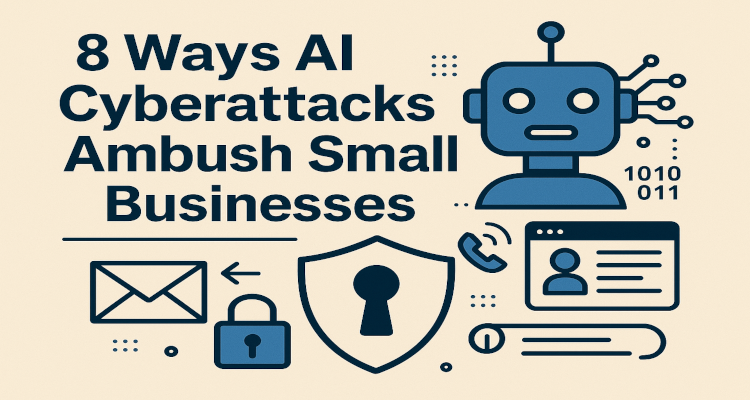Heads up: This post may have affiliate links. As an Amazon Associate, I earn from qualifying purchases.

8 Ways AI Cyberattacks Ambush Small Businesses (And How to Shut the Door Fast)
The world shifted while most folks were sleeping. One-minute cyberthreats were a distant worry for big corporations; the next minute small businesses found themselves staring down attacks built by machines that don’t get tired, don’t make mistakes and don’t wait for office hours.
If you run a shop, a studio, a fleet, a freelance gig or anything in between, you’re now sitting in the splash zone of the fastest-growing threat on the planet: AI-driven cyberattacks.
And they’re hitting small businesses harder than anyone wants to admit.
Let’s break down how these attacks land, why they work and the eight simple moves that keep your business upright.
The New Attacker in the Dark
The old stereotype, some hoodie-wearing hacker with Mountain Dew stains on his shirt is outdated. Today’s attacks come from AI bots that scrape your entire online presence in minutes. They learn how you write, who you pay, what your invoices look like, and what time of day you’re distracted.
They tailor every email, fake every signature, mimic every voice pattern, and slip through every crack you didn’t even know existed.
It’s not paranoia. It’s the new normal.
The 8 Fastest Ways AI Breaks into Small Businesses
1. Flawless Fake Emails
Phishing used to be easy to spot. Misspellings, weird grammar, strange names.
AI wiped all that out.
Now the scam looks like it came straight from your bank or accountant. Click once and the damage is done.
2. Invoice Cloning
AI bots grab samples of your outgoing invoices, copy the format and send a near-perfect fake to your clients or to you.
Money slips right out the door without resistance.
3. Password Cracking in Minutes
AI-powered brute force isn’t slow.
Short passwords and predictable patterns get shredded instantly.
4. Malicious Attachments That Look Legit
PDFs, resumes, vendor forms, tax statements—AI wraps malware inside documents your team handles every day.
One distracted employee ruins a whole month.
5. Deepfake Voice Scams
With ten seconds of audio, AI can sound exactly like you.
Imagine your team receiving a call that sounds like your voice saying, “Send five grand to this vendor before end of day.”
People fall for it because it sounds true.
6. Highly Personalized Targeting
AI stalks your website, socials, bios, reviews, and vendor lists.
Then it sends spear-phishing attacks that feel tailor-made.
Because they are.
7. Automated Web Attacks
Your website, blog dashboard, CMS, Shopify store, AI can hammer it with password attempts and exploit scans nonstop until it hits gold.
8. Vendor Breach Blowback
Sometimes you do nothing wrong.
A vendor gets hacked, their data leaks, and suddenly your phone is blowing up with scam texts and fake confirmations.
That’s the new battlefield.
The Armor: 8 Steps That Protect Small Businesses Right Now
You don’t need enterprise cybersecurity. You need discipline, good habits, and strong locks.
1. Turn On Multi-Factor Authentication
MFA stops most attacks dead.
Bank accounts, email, payroll dashboards, lock them down today.
2. Use Strong, Unique Passwords
No birthdays. No business names. No recycled patterns.
Use a password manager and long passphrases.
3. Update Everything Weekly
Laptops, phones, routers, point-of-sale devices, CMS plugins, patch them.
Every update closes a hole.
4. Train Your Team Without Boring Them
Skip the corporate handbook.
Show them real phishing examples.
Teach one rule: If it looks off, ask.
5. Verify Money with a Known Number
No transactions happen without a call to a saved number.
Not the number in the email. Not the one in the voicemail.
The number you already trust.
6. Back Up Your Systems Twice
One local backup. One cloud backup.
If ransomware hits, you’re down minutes not days.
7. Lock Down Your Website
Install security plugins. Update themes and CMS cores.
Use hosting that scans for malware.
Your website is your weakest link if you ignore it.
8. Review Access Monthly
Who can touch money?
Who can touch passwords?
Who can change settings?
Cut access levels to the bone.
A Quick “AI Threat Check” You Can Do Today
Ask yourself and your crew:
-
Could someone fake my voice and get my team to send money?
-
Do we verify payments the same way every time?
-
If one laptop died today, could we still run the business?
-
Are our passwords unique across the board?
-
Could someone imitate my invoices perfectly?
The answers tell you how exposed you are.
The Real Truth: Small Businesses Can Absolutely Win This Fight
AI gives attackers scale, speed and precision.
But small businesses have something stronger: agility.
No committees. No red tape.
If you decide to tighten your defenses today, you can close most vulnerabilities before sundown.
This new world isn’t about fear, it’s about clarity.
AI might be powerful, but a business built with discipline, clean systems, and a healthy suspicion for digital nonsense stands firm.
Stay sharp. Stay grounded. Keep the doors locked and your team awake to the world you’re working in.
